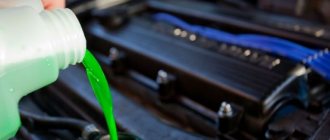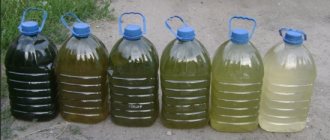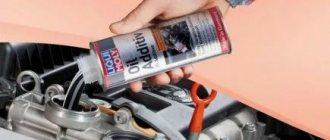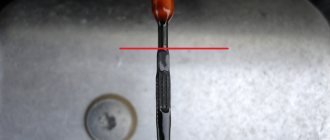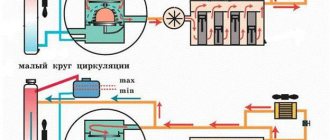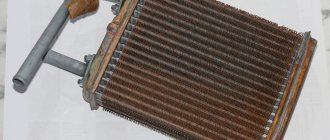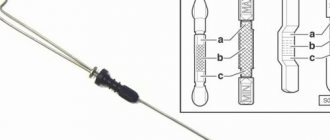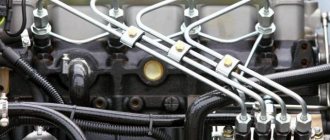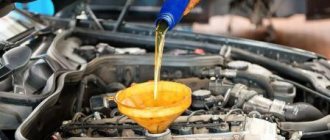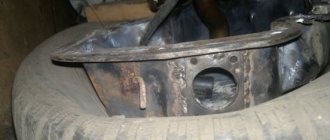Continuing the topic of flushing the engine and its systems, it should be noted that during operation quite often there is a need to flush the lubrication system. Such flushing of the oil system may be required for a number of reasons, ranging from switching to a different type of engine oil to emergency malfunctions.
As a rule, the reason for immediately flushing the lubrication system is that antifreeze or antifreeze gets into the oil, resulting in an emulsion in the engine. Even taking into account the fact that the motor oil itself has a whole package of not only protective, but also detergent and dispersant components, these properties may not be enough.
In other words, after filling, fresh oil is simply not capable of efficiently cleaning the surfaces of parts and channels in the engine from various deposits, precipitated sediment and other by-products that form after mixing with coolant.
Next, we will talk about what to do after antifreeze has been detected in the engine lubrication system, how to flush the engine after eliminating the main cause of the malfunction, and also how to flush the engine from the emulsion or its residues.
Flushing the engine oil system: when needed
So, antifreeze or antifreeze can get into the lubrication system for various reasons, but the most common culprit is damage to the cylinder head gasket. Less commonly, cracks form in the block or head. In any case, the result of mixing oil and coolant is an emulsion.
This phenomenon is very dangerous for the engine, since the lubricant loses its properties, and the wear of the cylinder head, crankshaft, timing gear and other elements and components in the internal combustion engine increases significantly. Moreover, water and ethylene glycol, mixed in certain proportions and, in fact, representing coolant, after entering the oil, cause coagulation of various contaminants.
Simply put, dirt in the lubrication system literally sticks together. Additives in oil and antifreeze react after mixing and quickly decompose, the oil immediately oxidizes, etc. Large “lumps” consisting of deposits can even clog the oil receiver mesh filter, resulting in
engine oil starvation
.
It is important to take into account that, for example, after replacing the cylinder head gasket, it will not be possible to completely drain the waste from the engine. This means that if you fill in a new portion of fresh lubricant, the lubricant will also mix with the remaining emulsion, and unwanted deposits will still form in the oil channels and on the internal surfaces of the engine.
If the engine is not additionally flushed, this situation will repeat for at least 2-3 more replacements. We also note that similar recommendations also apply when, for some reason, the oil change interval was violated (for example, the lubricant was replaced not after 10 thousand km, but after 15 thousand). Flushing is also recommended if it is necessary to add oil from a third-party manufacturer, when it was necessary to mix mineral oil and synthetics, etc.
At the same time, flushing the engine may be necessary if the owner purchased a used car, and the service history of a particular car is unknown or questioned. It often happens that after changing the oil on such a machine, the fresh lubricant turns black very quickly (literally after 50-100 km).
Finally, it is also worth highlighting the possible filling of low-grade oil into the engine. Among motor oils, unfortunately,
fakes are common
. Naturally, after discovering this fact, you need to remove the surrogate from the internal combustion engine, then the engine must be flushed.
A counterfeit product is usually indicated by strong and rapid blackening of the lubricant, an unpleasant pungent odor, the appearance of black deposits under the valve covers, cloudiness of the oil, a significant change in its viscosity for no obvious reason, increased lubricant consumption, engine smoking, etc.
Reviews from motorists who have tried the diesel fuel flushing method
Good reviews about the method of washing an engine with diesel fuel are mainly left by owners of outdated equipment. For example, drivers often wash ZMZ and VAZ engines with diesel fuel. Here, in most cases, there are no pronounced negative consequences. Although it is not a fact that in one wash the car owner did not reduce the engine life of thousands by 50 km.
You can also find negative reviews on the Internet. For example, after filling with diesel fuel, the engine seized. After disassembly, worn out and twisted liners were discovered.
Therefore, the conclusion about this method of cleaning the engine is this: you can use diesel fuel, but carefully and only on well-preserved outdated engines.
To keep your car's engine running like a clock, you must adhere to service intervals and contact a car service center in a timely manner - this is the basic rule of official repair shops. But who adheres to the rules... Let's figure out whether flushing the engine with diesel fuel is necessary, what goals are being pursued, and what effect can be achieved.
Description of the problem
A dipstick is used to check the lubricant level in the engine crankcase. When the element is removed from the engine, a cloudy white or yellowish coating mixed with engine oil appears on the surface. A similar emulsion is formed on the inner surface of the plug installed in the hole for filling lubricant into the engine. The car owner needs to understand why the foreign deposit has formed.
How to properly flush the cooling system
Any car engine cooling system (ECS) consists of water pipes (hoses), radiators (main and heating), a thermostat, and a water pump, which ensures forced circulation of coolant. As a result of constant interaction with heated metal, as well as from aging, various deposits accumulate in the liquid (antifreeze or antifreeze), and it begins to become cloudy. Oil from the engine can also get into the antifreeze; it penetrates into the ODS due to a leak in the cylinder head gasket.
There are different methods for flushing cooling channels and radiators, in general they are not fundamentally different from each other, the difference lies only in the use of compositions and the sequence of actions. You can flush the engine cooling system with water without resorting to any chemicals, but this is the case when it is not too dirty and there are no traces of oil in it. Properly flushing the SOD means completely getting rid of dirt or oil (emulsion), while the antifreeze must be transparent and the engine must be at operating temperature (not overheat). And it is very important to choose a composition suitable for washing that will not harm the car, but will only benefit it!
Cleaning SOD using “Whiteness”
The cooling system can become clogged due to the mixing of two different coolants that are incompatible in characteristics; this causes the liquid to clot, resulting in a kind of “porridge”. It is not easy to wash such slurry out of RO; industrial chemicals very rarely help here. For washing, folk craftsmen use the cleaning agent “Belizna”, which has an excellent cleansing effect. What does the application of this composition look like in practice:
- as usual, drain the liquid from the cylinder block and radiator;
- Without closing the plugs, pour with plain water (up to 10 liters);
- close the drain taps (plugs), fill in 2 liters of “Belizna”, take this amount if the volume of the cooling system is about 10 liters, fill the remaining space of the SOD with water;
- we start and heat the engine to operating temperature (at least until the cooling fan starts for the first time), turn off the engine, drain the liquid;
- pour the SOD a second time until the flowing liquid becomes clear; if necessary, repeat the rinsing with distilled water.
Now the expansion tank can be filled with fresh antifreeze, and as the machine operates, it is advisable to monitor the color of the coolant. According to reviews from car owners, Belizna effectively removes dirt from radiators, but it has its drawbacks - it has a strong smell, and the product also corrodes aluminum. Therefore, when washing after using a cleaning agent, its residues must be thoroughly washed away to avoid metal corrosion.
What is the engine lubrication system?
This system, by reducing the frictional forces of the elements, increases the life expectancy of all components of the device. As an addition, oil removes excess heat that is generated during the operation of components or a specific element. In order to achieve the maximum positive effect from the lubrication system, it is important to fill in the engine oil that will fully correspond to the operating modes of the engine.
The main components that make up the engine lubrication system:
- Filter.
- Oil pump.
- The oil pan contains most of the oil.
- Hoses and supply tubes.
The system is perfectly sealed, so it will be problematic for other liquids to get there. This was achieved by installing many gaskets and seals.
When the engine starts, the oil pump starts working and gradually increases the pressure. Oil flows through the system, having previously passed through a cleaning filter. The fluid primarily lubricates the components where severe wear is possible - the crankshaft journal, camshafts and valves. After which it drains into the crankcase, where it hits the connecting rod and is scattered onto the cylinder walls. Next, the oil scraper rings clean the cylinders. The entire lubrication process is uninterrupted and lasts as long as the motor is running.
Consequences of emulsion in the engine
The formation of a foam emulsion in oil can lead to the following consequences:
- oil characteristics change;
- engine parts are poorly lubricated (in particular, main and connecting rod bearings, valves, cylinder walls, piston group), which leads to a decrease in their service life and the service life of the entire engine;
- Engine power decreases.
If the emulsion in the engine is formed not in the oil system, but in the cooling system, this can lead to the following consequences:
- frequent overheating of the engine, boiling of the coolant;
- the emulsion clogs pipes and hoses to a critical level when antifreeze circulation is impossible;
- reduction in the service life of the engine and its individual parts.
Therefore, when an emulsion is formed in individual parts of the engine, there is no need to “turn a blind eye” to this. Instead, you need to find out as quickly as possible why it forms and take repair measures.
Features of VAZ cylinder heads
The cylinder heads of engines installed on VAZ modifications 2101, 2102, 2103, 2104, 2105, 2106, 2107 have special aluminum plugs. These plugs block the access of coolant to the cylinder head. Sometimes (especially in very old cars) these plugs can break down and leak, allowing coolant to leak into the oil. For this reason, owners of the modifications listed above should take this defect into account, since it is not typical for most car models.
Conclusion
Perhaps the most reliable way to protect your engine from problems with the emulsion is attentiveness. Signs indicating the formation of a dangerous concentration of emulsion in the engine are not so difficult to notice and detect. And when identifying them, you just need to follow simple rules and recommendations. This approach will avoid high repair costs and save your time.
Video about emulsion in the engine:
How to flush the engine from emulsion, dirt and deposits
It is quite obvious that if you need to wash the engine from the inside, then you need a good engine flush. There are a large number of different formulations on sale.
In practice, all products can be divided into two groups:
- additives for mining;
- flushing oils;
However, choosing the best engine flush product is not so easy. First of all, you need to proceed from the specific situation. If you just need to flush the lubrication system before changing the oil, and we are not talking about removing remnants of an emulsion or counterfeit product, then a regular “five-minute” may be quite enough.
The only thing is that this method should be used with caution on old engines. The fact is that over long runs the unit will definitely be dirty, while the “five-minute” ones are very aggressive and separate accumulated deposits in the pan, but do not dissolve them. Such deposits may well clog the oil receiver with all the ensuing consequences.
It should also be remembered that quick flushes in oil can also have a negative effect on gaskets, seals and other seals. There have been cases where, after applying oil flushes, the engine began to leak.
- In case of more serious contamination, it is better to use ready-made flushing oils, which are poured into the engine in full instead of base oil. Depending on the type of flushing composition, the unit should either operate only at idle speed, or short-term driving with minimal loads on the internal combustion engine is allowed.
This type of washing is less aggressive to rubber seals compared to “five-minute” ones, and also more thoroughly washes away dirt and deposits. We also note that flushing oils can be synthetic, semi-synthetic or mineral, and are also universal. In other words, they can be used in both gasoline and diesel internal combustion engines.
In practice, this solution can be considered optimal for flushing the engine from emulsion after antifreeze or antifreeze gets into the lubrication system. Flushing oils are also better suited for cleaning dirty internal combustion engines with high mileage.
At the same time, the risk of “clogging” the channels and filters (for example, in hydraulic compensators, the oil receiver mesh) with soggy dirt is still present, but it is not as high as compared to a quick rinse in engine oil.
Advantages of diesel fuel
Despite the fact that there are many special flushing liquids on the market, diesel fuel is still actively used and poses quite serious competition. At the same time, it does not adversely affect metal, seals and gaskets, and the reliability of engine flushing with diesel fuel has been tested for decades. Diesel is also cheap. Therefore, you can safely resort to it.
In reviews, flushing the engine with diesel fuel before changing the oil is recommended when using fuel together with oil. This mixture is easy to create - you just need to mix the ingredients. The engine can also be cleaned using kerosene, which is also an excellent solvent and easily copes with oily contaminants and deposits.
How to flush the engine after emulsion. Rinse after emulsion Score:
#1 nickolaus
- Group: Users
- Posts: 546
- Registration: 16 June 05
- Thanked: 0
- Gender: Man
- City: Kyiv
- Real name: Nikolai
- Car: GAZ-21L 1964; GAZ-21R 1968;
- Phone: via PM
- Age: 33
- Attitude towards authenticity: Minor changes
If the moderator decides to attach this topic to an existing one, I will be only too happy. I couldn’t find a similar topic, but many people have similar problems. Therefore, if this thread remains, then you can delete this introduction.
So, the cases are different, someone had a gasket blown and water got into the crankcase, someone had a hole in the exhaust (or intake) duct at the junction with the water jacket in the head of the block - as it happened to me, someone then similar problems with the cylinder block. As a result, the problems were eliminated, but the emulsion remained everywhere in the system. I’ll tell you right away that I didn’t have much of it: there was an emulsion on the oil filler cap, on the top of the dipstick, and on the rocker cover - I cleaned/wiped it off when replacing the head. But there is an emulsion in the system and this is a fact. Even a little on the dipstick, although homogeneous, is clearly somehow more liquid than it should be, and the color, I would say, is like instant coffee (instead of the usual black). I heard two opinions: 1) My father said that when he drowned his engine (along with the car), it required multiple oil changes (4-5-6 times), albeit cheap, but after 100-200-300 km. Naturally, the first time the emulsion was poured onto the hot one, the flush was poured in, it worked for 15-20 minutes, after which the first batch of “cheap” oil was poured in. I emphasize that it is cheap because it still lasts 200-350 km. Thus, we managed to avoid troubles and the engine still works well to this day. 2) In order to properly flush the system, it is necessary to remove the engine, sump, crankshaft, etc. and thoroughly wash the engine with shampoos, etc., dry it, and fill it with oil. They say that without this, the emulsion will not go anywhere, some amount will remain and will constantly spoil the oil, which will subsequently be filled. I’ll say right away that I chose the first option, because... Now there is not enough energy, time and other things for more detailed repairs. And even if I had decided on it, I would have already done a major overhaul with defects in the tires, liners, packing, and grinding of the crankshaft. But in my case this is not now. And now, when I am writing these lines, my father is 1) draining the emulsion, 2) pouring in the old MT-16 tank oil in stock (as a flush), 3) pouring in inexpensive simple M8B, if after filling MT-16 a large amount is not formed emulsion (by eye - how else?), on which 1500-2500 km are driven, after which 4) oil from a good manufacturer (Shell, Mobil, Castrol, etc.) type 20W50 is filled in. The main question in this subparagraph is whether this idea is clearly erroneous and whether these actions will ruin the engine? I kindly ask you to confirm or refute my ideas, as well as express your own. I think this information can be useful to many to avoid mistakes in the future. Thank you.
#2 VOV21
- Group: Users
- Posts: 1,478
- Registration: 30 November 04
- Thanked: 0
- Gender: Man
- City: Kyiv
- Real name: Vladimir
- Car: GAZ-21S 1969
- Age: 53
- Attitude towards authenticity: Minor changes
#3 Lev
- Group: Moderators
- Posts: 5,037
- Registration: 03 September 05
- Thanked: 0
- Gender: Man
- Voronezh city
- Enter characters: dfg-23-s5-g: dfg-23-s5-g
- Real name: Leo
- Car: M-21V 58, SZD 90,
- Age: 47
- Attitude towards authenticity: Look at yourself!
Post edited by Lev: May 16, 2006 - 13:43
#4 nickolaus
- Group: Users
- Posts: 546
- Registration: 16 June 05
- Thanked: 0
- Gender: Man
- City: Kyiv
- Real name: Nikolai
- Car: GAZ-21L 1964; GAZ-21R 1968;
- Phone: via PM
- Age: 33
- Attitude towards authenticity: Minor changes
#5 Lev
- Group: Moderators
- Posts: 5,037
- Registration: 03 September 05
- Thanked: 0
- Gender: Man
- Voronezh city
- Enter characters: dfg-23-s5-g: dfg-23-s5-g
- Real name: Leo
- Car: M-21V 58, SZD 90,
- Age: 47
- Attitude towards authenticity: Look at yourself!
#6 Man-in-Slippers
- Group: Users
- Posts: 2,346
- Registration: 06 October 05
- Thanked: 0
- Gender: Man
- City: Moscow, South-Western Administrative District
- Real name: Sergey
- Car: GAZ-3110, moped Riga-3
- Phone: +7 906 7618143
- Age: 27
- Attitude towards authenticity: Other
#7 nickolaus
- Group: Users
- Posts: 546
- Registration: 16 June 05
- Thanked: 0
- Gender: Man
- City: Kyiv
- Real name: Nikolai
- Car: GAZ-21L 1964; GAZ-21R 1968;
- Phone: via PM
- Age: 33
- Attitude towards authenticity: Minor changes
#8 Man-in-Slippers
- Group: Users
- Posts: 2,346
- Registration: 06 October 05
- Thanked: 0
- Gender: Man
- City: Moscow, South-Western Administrative District
- Real name: Sergey
- Car: GAZ-3110, moped Riga-3
- Phone: +7 906 7618143
- Age: 27
- Attitude towards authenticity: Other
So alcohol cannot live without water, why do you think the brake system is flushed with it?
And instead of starting the engine with diesel fuel instead of oil, it was worth turning out the spark plugs and turning the starter for the same half a minute.
#9 Mayor
- Group: Users
- Posts: 8,682
- Registration: 26 November 04
- Thanked: 0
- Gender: Man
- City: Baku Azerbaijan
- Real name: Adil Mehmandarov
- Car: GAZ-21R 1966/1966
- Age: 55
- Attitude towards authenticity: Supporter of modernization
nickolaus (17.5.2006, 16:56) wrote:
Yes, but only if it is clearly established that the flow of coolant into the crankcase has been stopped. Otherwise, you won’t understand. The residues are evaporated, or the coolant is supplied again. Can we still drain the oil and see if, for example, coolant drips from the crankcase drain hole during the night?
A mixture with water is a very bad lubricant. It has a great effect on the wear of the piston ring grooves, and the rings themselves.
#10 nickolaus
- Group: Users
- Posts: 546
- Registration: 16 June 05
- Thanked: 0
- Gender: Man
- City: Kyiv
- Real name: Nikolai
- Car: GAZ-21L 1964; GAZ-21R 1968;
- Phone: via PM
- Age: 33
- Attitude towards authenticity: Minor changes
#11 OLD
- Group: Users
- Posts: 532
- Registration: 29 December 04
- Thanked: 0
- Gender: Man
- City: Moscow, SEAD
- Real name: Evgeniy
- Car: UAZ Patriot
- Phone: Seamans
- Age: 32
- Attitude towards authenticity: I strive for 100% original
Best regards, Evgeniy.
Any sequence of events is always correct.
#12 Mayor
- Group: Users
- Posts: 8,682
- Registration: 26 November 04
- Thanked: 0
- Gender: Man
- City: Baku Azerbaijan
- Real name: Adil Mehmandarov
- Car: GAZ-21R 1966/1966
- Age: 55
- Attitude towards authenticity: Supporter of modernization
nickolaus (18.5.2006, 13:05) wrote:
The rings could of course become coked.
#13 nickolaus
- Group: Users
- Posts: 546
- Registration: 16 June 05
- Thanked: 0
- Gender: Man
- City: Kyiv
- Real name: Nikolai
- Car: GAZ-21L 1964; GAZ-21R 1968;
- Phone: via PM
- Age: 33
- Attitude towards authenticity: Minor changes
#14 Bumblebee
- Group: Users
- Posts: 612
- Registration: 12 May 05
- Thanked: 0
- Gender: Man
- Moscow city
- Real name: Edward
- Car: GAZ-21US 1970
- Phone: I'll tell you!
- Attitude towards authenticity: I strive for 100% original
Don't touch the equipment and it won't let you down!
#15 VOV21
- Group: Users
- Posts: 1,478
- Registration: 30 November 04
- Thanked: 0
- Gender: Man
- City: Kyiv
- Real name: Vladimir
- Car: GAZ-21S 1969
- Age: 53
- Attitude towards authenticity: Minor changes
nickolaus (18.5.2006, 11:42) wrote:
Yes, there are some miracles with overheating. I bought a white one with a 24 engine and a 24 radiator. In summer for 10 min. It was impossible to stop in a traffic jam, just under 100 degrees. I replaced the radiator with the original one and it gets hot. I installed another original radiator and it also gets hot. Over time, due to the engine being dead, I changed it to the 402. It gets hot. I installed an additional gazelle water pump; the plugs still get hot; it is contraindicated. So for now my father-in-law drives it in the village. It suits her there. On the black one, the situation is exactly the opposite: the radiator is original, the 24 engine does not overheat. It always stays at 80, and even in traffic, there is a slight increase to 85-90 on long climbs, and then it’s normal again. I don’t know how to explain this. Misita somehow
#16 nickolaus
- Group: Users
- Posts: 546
- Registration: 16 June 05
- Thanked: 0
- Gender: Man
- City: Kyiv
- Real name: Nikolai
- Car: GAZ-21L 1964; GAZ-21R 1968;
- Phone: via PM
- Age: 33
- Attitude towards authenticity: Minor changes
#17 Man-in-Slippers
- Group: Users
- Posts: 2,346
- Registration: 06 October 05
- Thanked: 0
- Gender: Man
- City: Moscow, South-Western Administrative District
- Real name: Sergey
- Car: GAZ-3110, moped Riga-3
- Phone: +7 906 7618143
- Age: 27
- Attitude towards authenticity: Other
#18 ManCar
- Group: Users
- Posts: 838
- Registration: 07 June 05
- Thanked: 0
- Gender: Man
- City: Ukraine, Kharkov
- Real name: Alexey
- Car: GAZ-21L Jan. 1964
- Age: 40
- Attitude towards authenticity: Minor changes
#19 nickolaus
- Group: Users
- Posts: 546
- Registration: 16 June 05
- Thanked: 0
- Gender: Man
- City: Kyiv
- Real name: Nikolai
- Car: GAZ-21L 1964; GAZ-21R 1968;
- Phone: via PM
- Age: 33
- Attitude towards authenticity: Minor changes
#20 ManCar
- Group: Users
- Posts: 838
- Registration: 07 June 05
- Thanked: 0
- Gender: Man
- City: Ukraine, Kharkov
- Real name: Alexey
- Car: GAZ-21L Jan. 1964
- Age: 40
- Attitude towards authenticity: Minor changes
Post edited by ManCar: May 19, 2006 - 12:12
Source
How can you tell if the oil is mixed?
Experts identify several main signs that indicate depressurization of the system:
- The antifreeze in the tank will have oil stains.
- Compression decreases.
- You can see oil leaks under the cylinder head.
- The amount of antifreeze is constantly decreasing.
- The presence of white smoke even on a warm engine.
Thus, the tightness of the lubrication system can be diagnosed visually.
There is another way that will help determine the presence of oil vapors in the exhaust gases. To carry out such a test, you need to warm up the engine thoroughly. Next, cover the exhaust pipe with a clean sheet of paper for a few seconds. The sheet of paper will be damp. It needs to be dried and examined. If there are oil stains on the sheet, then there are leaks somewhere. Leaks need to be fixed.
If all these signs do not occur, then you should look for a different reason.
Chemical incompatibility
It is necessary to add the same engine oil as was added during replacement. Mineral oil is in no way compatible with synthetic oil. This “mix” disrupts the structure of the liquid. This is due to the fact that in mineral oil the hydrocarbon molecules have a wide range in size, while in synthetic oil all the molecules are homogeneous.
Due to the different molecular sizes of mineral oil, it performs well under operating temperature changes. Thus, the viscosity, freezing temperature and level of lubrication of the rubbing elements by the liquid change.
As you know, oil is not completely homogeneous. It contains various additives. They vary depending on which area needs more lubricity to be added. It happens that the added additive begins to enter into a chemical reaction with the poured oil, which leads to the appearance of foam.
Flaws
Cleaners or diesel fuel cannot completely remove deposits from the internal combustion engine due to the presence of hard-to-reach channels.
Result after manual washing. Using diesel fuel as a flushing liquid will not give this result.
For example, diesel fuel, being a fuel, does not dissolve slags and carbon deposits, but peels them off from the walls. These contaminants, which are not completely removed, circulate with fresh motor oil, impairing its beneficial properties. That is, exfoliated contaminants are poorly washed out completely when drained.
Broken gasket
Most often, liquid in the oil appears due to a breakdown in the cylinder head gasket. A leak usually occurs either due to overheating (the gasket burns out) or due to physical wear of the gasket. When an engine overheats, you should always check the condition of the oil. An engine that is more than ten years old may have a gasket that has simply physically worn out.
If the engine begins to operate unstably, then it is necessary to check the gaskets. Liquid may leak from the cooling system. If detected in a timely manner, this malfunction can be easily eliminated by simply replacing the gasket with a new one. You may not even have to sand.
Condensation has appeared
If water enters the lubricating system, then the oil completely changes its properties. The oil will not be able to dissolve without a residue, but with prolonged mixing, an emulsion can form. This is the kind of liquid the driver detects on the dipstick. Even if the oil has just been changed, the water that gets in will completely change its properties.
Don't be afraid that there is a leak somewhere. Water in the cylinders may appear from the air. And that's a fact. If the ambient temperature has a large difference with the temperature of the metal parts of the engine, then condensation may settle on the cylinder walls. Typically, this phenomenon can be encountered in the fall or winter, when the car is parked on the street. Water condenses on the metal and flows into the crankcase, where it mixes with the oil. The result is foam.
In order to somehow overcome this problem, you need to warm up the engine thoroughly and for a long time in the winter. Then the water will simply evaporate. Experts also recommend insulating the engine to quickly warm it up in the morning.
Video
Emulsion under the valve cover
Do not be alarmed if you find an emulsion under the oil filler cap, but the oil on the dipstick is in normal condition. The accumulation of plaque, whose consistency and color resembles condensed milk, occurs due to moisture condensation. The autumn-winter period and frequent trips over short distances are the most favorable conditions for the accumulation of condensation.
In the crankcase ventilation system, air mixed with combustion products of the air-fuel mixture and oil vapor has a certain percentage of humidity. The heated mixture inevitably condenses on cooled surfaces. But when the engine and all its parts warm up, the moisture gradually evaporates. With frequent cold starts and short runs, some elements do not have time to warm up to the temperature required for evaporation. As a result, the emulsion accumulates under the oil filler cap.
Is it possible to overcome the problem?
The emulsion itself under the engine cover is not dangerous. It is enough to wipe it occasionally with a clean cloth. If the car is the second in the family and is used only in the city, try to periodically go on the highway with it. Long periods of operation within the operating temperature range will prevent emulsion accumulation.
On gasoline internal combustion engines, frequent cold starts and short distances are also dangerous due to the accumulation of gasoline in the oil. In the start-up and warm-up modes, the ECU enriches the mixture, which causes more gasoline to enter the crankcase through the piston rings. Fuel dilutes the oil and impairs its lubricating properties. Under such conditions, loaded friction pairs wear out intensively: cylinder walls, liners, crankshaft journals, camshafts. When a warm engine runs for a long time, gasoline naturally evaporates from the oil and enters the intake manifold through the crankcase ventilation system.
Pay attention to the crankcase ventilation system
Much more dangerous is the accumulation of condensate in remote oil separators, tees and hoses of the crankcase ventilation system. This situation occurs in severe frost and most often after long periods of idle time. At idle speed, a small amount of exhaust gases breaks into the crankcase, while the vacuum in the intake manifold is close to maximum (the throttle is closed or slightly open at a small angle). In order not to create unnecessary vacuum in the crankcase, the system takes in air through a hose cut into the corrugation up to the throttle valve. When heated gases mix with frosty air in the tee, the accumulating condensate freezes, blocking the passage of crankcase gases. In the best case, after this, the gases push out the dipstick, splashing the engine compartment with oil, in the worst case, they squeeze out the seals.
Cooling System Maintenance
During the operation of the vehicle, antifreeze (antifreeze) gradually loses its qualities and begins to become cloudy due to constant circulation, heating and interaction with metal. The frequency of coolant replacement depends on many factors, but in general it is recommended to change the coolant every 40-50 thousand kilometers traveled or regularly once every 2 years (in some cases - 5 years). The fluid is also replaced:
- when it becomes cloudy (blackened);
- if oil gets into it;
- when foam or flakes appear.
If the coolant has acquired a red color, the reason for this is the formation of rust; here you cannot delay replacing the antifreeze, and you need to find out what is causing the rusting. If you replace the fluid on time (according to the regulations) and prevent it from becoming cloudy, most likely, global flushing will not be necessary; when changing antifreeze, it is enough to flush the system with distilled water.
Video: How and with what to flush the radiator and cooling system of a car engine
